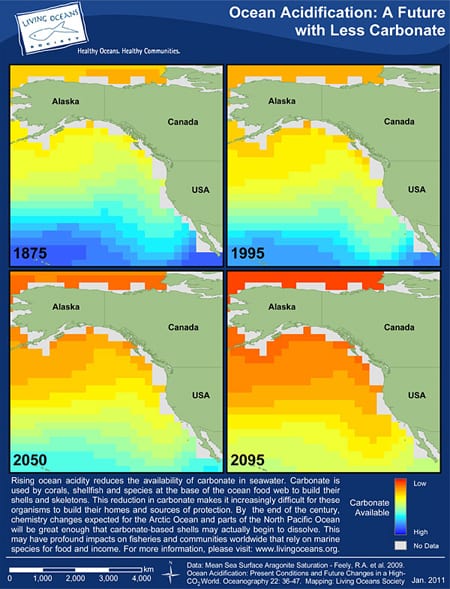By Daniel de la Calle
Some Ocean Acidification news for this beginning of May:
¤Symposium on Ocean Acidification to be held in Canberra, Australia from the 15th to the 17th of June 2011.
The event is titled Ocean Acidification and Implications for Living Marine Resources in the Southern Hemisphere and aims to: “enhance the understanding of key challenges and developments in acidification research,
facilitate national and international collaboration and networks
, share perspectives of national and international leaders in the field,
develop interactions with government agencies charged with addressing the issue.”
Guest speakers include:
Dr Richard Feely, National Oceanic and Atmospheric Administration (NOAA), United States of America (USA)
, Dr Catriona Hurd, University of Otago, New Zealand
, Dr Chris Langdon, University of Miami, (USA),
Dr Phil Munday, James Cook University, Australia
, Dr Yukihiro Nojiri, National Institute for Environmental Studies, Japan.
Info HERE
¤A University of Plymouth research group has received a €3.5 million grant from the European Commission to fund research on the effects of Ocean Acidification. Dr Jason Hall-Spencer, in charge of the project, is collaborating with scientists from the USA, Brazil, Canada, Germany, Italy, Israel, France, Spain and Monaco to discover the effects of rising CO2 levels on coastal habitats. This international team of divers is studying a series of giant underwater volcanoes, which allows the scientists to discern what dies and what can survive as coastal areas become more acidified. Aside from appearing in Elizabeth Kolbert’s article on this month’s issue of National Geographic, their film channel has also made a documentary called One Ocean: The Changing Sea about Mr. Hall’s research into CO2 vents that has been broadcast in 167 countries. Part of the money comes from the MedSeA grant that I wrote about on a previous post.
¤Map from the Living Oceans Society showing the decline of carbonate in time on the Pacific West Coast.

¤ Krill decline is affecting penguin populations in Antarctica. A study titled Penguins in peril: variability in krill biomass links harvesting and climate warming to penguin population changes in Antarctica by Dr. Wayne Trivelpiece of NOAA and his colleagues indicates that both adelie (or “ice-loving”) and chinstrap (or “ice-avoiding”) penguin populations have declined by more than 50% in certain regions of the Antarctic since the 1970s. This could prove that lower numbers are not so much due to sea-ice cover, but more related to krill abundance. Due to intensive whaling in the 19th and early 20th Century penguins could have had access to an extra 150 million tons of krill during that time. But rising temperatures, recovering whale and fur seal populations and the commercial krill fishery have depressed krill abundance by almost 80% in the Southern Ocean. The Southern Ocean is also a major sink for atmospheric CO2, so those lower pH levels could already be impacting on the ability of krill to form their shells.
“Penguins are excellent indicators of changes to the biological and environmental health of the broader ecosystem because they are easily accessible while breeding on land, yet they depend entirely on food resources from the sea. In addition, unlike many other krill-eating top predators in the Antarctic, such as whales and fur seals, they were not hunted by humans,” said Dr. Trivelpiece. “When we see steep declines in populations, as we have been documenting with both chinstrap and Adelie penguins, we know there’s a much larger ecological problem.”
These findings are specially vital for chinstrap penguins, since they breed almost solely in the area studied.
Parcial source for this news HERE.
¤One more short video on Ocean Acidification with Mark Green, from Saint Joseph’s College, done for the Sustainable Fisheries Partnership.
¤New video about OA from MSNBC.COM


